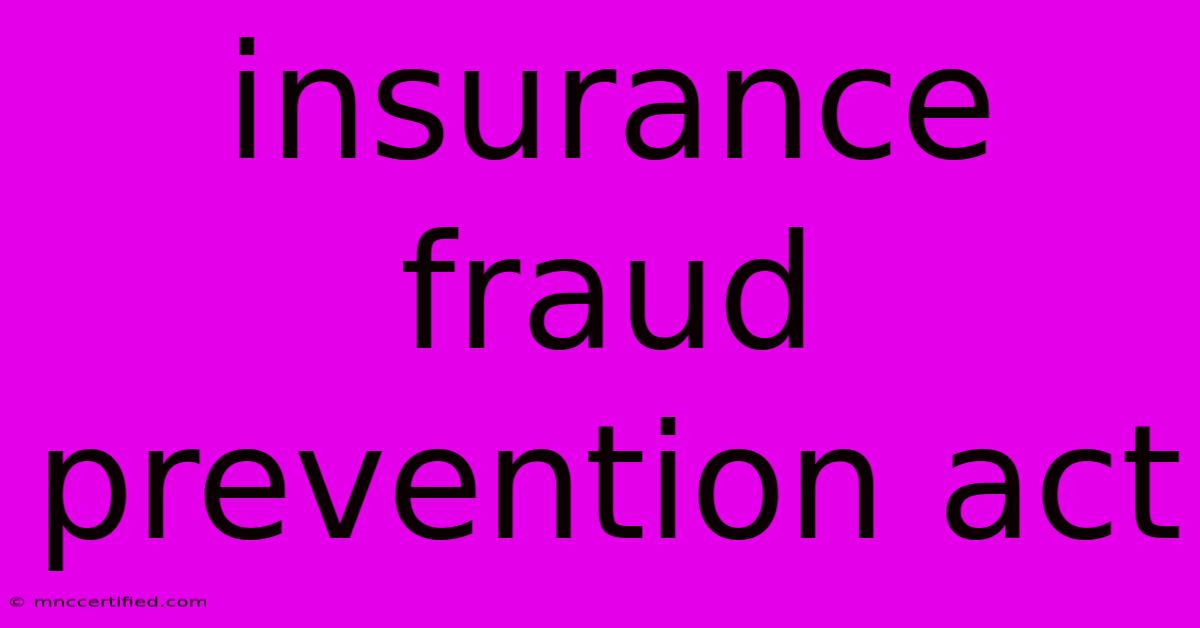Insurance Fraud Prevention Act

Table of Contents
Insurance Fraud Prevention Act: Protecting Insurers and Policyholders
Insurance fraud is a significant problem, costing billions of dollars annually and impacting everyone through increased premiums. Combating this requires a multi-pronged approach, and legislation plays a crucial role. While there isn't a single, overarching "Insurance Fraud Prevention Act" at the federal level in the United States, numerous state and federal laws work together to prevent and prosecute insurance fraud. This article will explore these laws and the broader strategies employed to prevent this costly crime.
Understanding the Scope of Insurance Fraud
Insurance fraud encompasses a wide range of deceptive practices, including:
- Hard Fraud: This involves intentionally staging an accident, filing a false claim, or exaggerating losses for personal gain. Examples include faking a car accident to claim insurance payouts or burning down a building to collect on fire insurance.
- Soft Fraud: This involves exaggerating claims or providing false information to receive a larger payout than deserved. Examples include inflating the value of stolen goods or claiming injuries that are not as severe as reported.
The consequences of insurance fraud are far-reaching. Increased premiums affect honest policyholders, while insurers face significant financial losses. Furthermore, the erosion of public trust in the insurance industry is a substantial consequence.
Key Legislative Measures & State-Specific Laws
While a singular federal "Insurance Fraud Prevention Act" doesn't exist, several federal laws address aspects of insurance fraud. These often focus on specific types of fraud or involve interstate commerce. The Federal Bureau of Investigation (FBI) plays a significant role in investigating major insurance fraud schemes that cross state lines.
State-level legislation is crucial in tackling insurance fraud. Each state has its own laws and regulations addressing various aspects of insurance fraud prevention and prosecution. These laws often define specific fraudulent acts, establish penalties, and empower regulatory bodies to investigate and prosecute offenders. For example, many states have specific laws concerning:
- Auto insurance fraud: This is a common target due to the prevalence of auto accidents. Laws often address staged accidents, fraudulent injury claims, and false reporting.
- Workers' compensation fraud: This involves false claims related to workplace injuries or illnesses.
- Health insurance fraud: This includes billing for services not rendered, upcoding (billing for more expensive services than provided), and false claims about medical conditions.
To find specifics for your state, searching "[your state] insurance fraud laws" is crucial. You will often find information on the state insurance department's website.
Prevention Strategies: A Multi-Faceted Approach
Effective insurance fraud prevention involves a comprehensive strategy including:
- Strengthening investigative capabilities: Insurers invest heavily in sophisticated fraud detection systems, employing data analytics and algorithms to identify suspicious patterns in claims.
- Enhanced data sharing: Collaboration between insurers and law enforcement agencies is crucial to share information and identify common fraudulent schemes.
- Public awareness campaigns: Educating the public about the consequences of insurance fraud and providing tips on how to avoid becoming a victim is a key preventative measure.
- Improved claim processes: Streamlining claim processes can reduce opportunities for fraud and make it easier to identify suspicious activity.
- Employee training: Insurers train their employees to recognize and report potential fraud.
The Role of Technology in Fraud Detection
Technology plays an increasingly important role in combating insurance fraud. Artificial intelligence (AI) and machine learning (ML) are being used to analyze vast datasets of claims data, identifying patterns and anomalies that might indicate fraud. This allows insurers to flag potentially fraudulent claims for further investigation more efficiently.
Conclusion: A Continuous Fight Against Insurance Fraud
The fight against insurance fraud is an ongoing battle requiring continuous adaptation and innovation. While a single, overarching federal act might not exist, the combination of federal and state laws, technological advancements, and proactive prevention strategies are crucial in minimizing the impact of this pervasive crime. Understanding these laws and the strategies employed is vital for both insurers and policyholders to protect themselves and the integrity of the insurance industry. Staying informed about updates in legislation and fraud prevention techniques is essential for continued protection.

Thank you for visiting our website wich cover about Insurance Fraud Prevention Act. We hope the information provided has been useful to you. Feel free to contact us if you have any questions or need further assistance. See you next time and dont miss to bookmark.
Featured Posts
-
Morrisons Faces Supply Chain Issues
Nov 27, 2024
-
Barcelonas Celta Vigo Game Injury Concern
Nov 27, 2024
-
Grealish Ake Nunes In Ucl Squad
Nov 27, 2024
-
This Morning Bonnie Blues Sleeping Scandal
Nov 27, 2024
-
Five Survive Red Sea Boat Sinking
Nov 27, 2024